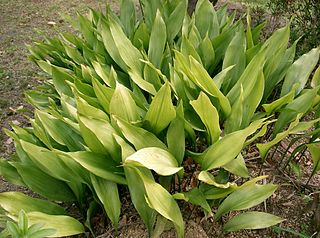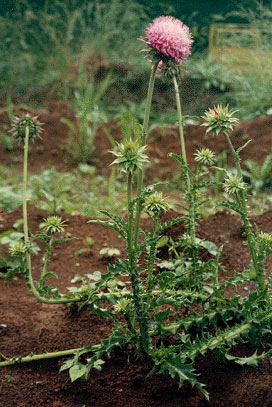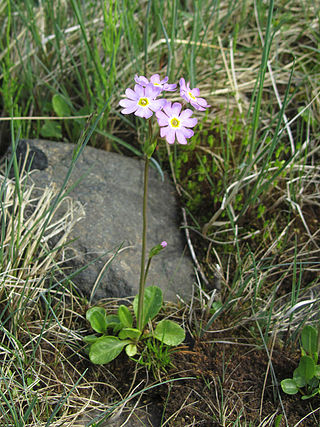
Keep the Aspidistra Flying, first published in 1936, is a socially critical novel by George Orwell. It is set in 1930s London. The main theme is Gordon Comstock's romantic ambition to defy worship of the money-god and status, and the dismal life that results.

Aspidistra is a genus of flowering plants in the family Asparagaceae, subfamily Nolinoideae, native to eastern and southeastern Asia, particularly China and Vietnam. They grow in shade under trees and shrubs. Their leaves arise more or less directly from ground level, where their flowers also appear. The number of species known has increased considerably from the 1980s onwards, with around 100 accepted as of July 2013. Aspidistra elatior is common worldwide as a foliage house plant that is very tolerant of neglect. It and other species can also be grown in shade outside, where they are generally hardy to −5 °C (23 °F).

Carduus nutans, with the common names musk thistle, nodding thistle, and nodding plumeless thistle, is a biennial plant in the daisy and sunflower family Asteraceae. It is native to regions of Eurasia.

Silene nutans is a flowering plant in the genus Silene, most commonly known as Nottingham catchfly.

Banksia nutans, commonly known as nodding banksia, is a species of shrub native to the south coast of Western Australia in the genus Banksia. Growing to a metre (3 ft) tall, it has pale blue-green fine-leaved foliage and unusual purple-brown inflorescences which hang upside down rather than grow upright like most other banksias.

Hopea is a genus of plants in the family Dipterocarpaceae. It contains some 113 species, distributed from Sri Lanka and southern India to the Andaman Islands, Myanmar, southern China, and southward throughout Malesia to New Guinea. They are mainly main and subcanopy trees of lowland rainforest, but some species can become also emergent trees, such as Hopea nutans.
Aspidistra is a plant genus.
Banksia nutans var. cernuella is a variety of Banksia nutans. It is native to the Southwest Botanical Province of Western Australia. Seeds do not require any treatment, and take around 17 days to germinate.
Banksia nutans var. nutans is a variety of the plant Banksia nutans. It is native to the Southwest Botanical Province of Western Australia. As an autonym, its name is defined as containing the type specimen of the species.
Aspidistra nikolaii is a plant species of the genus Aspidistra that was one of the new 21 species of plants and animals recently discovered in the Annamite Range of central Vietnam. It was named after a late Russian botanist named Nicolai Arnautov. It has a dark blue flower that is almost black.

Aspidistra elatior, the cast-iron-plant or bar-room plant, also known in Japanese as haran or baran (葉蘭) is a species of flowering plant in the family Asparagaceae, native to Japan and Taiwan. Tolerant of neglect, it is widely cultivated as a houseplant, but can also be grown outside in shade where temperatures remain above −5 °C (23 °F). It is used as training material for the seika form of ikebana.

Chrysopogon is a genus of tropical and subtropical plants in the grass family. They are widespread across Eurasia, Africa, Australia, southeastern North America, and various islands.
Lintonia is a genus of African plants in the grass family.

Homalanthus nutans, known locally as the mamala tree, is a species of plant in the family Euphorbiaceae. In Australia it is known as the bleeding heart and the Queensland poplar.
Hedyosmum nutans is a plant that was described by Olof Swartz. It is part of the genus Hedyosmum of the family Chloranthaceae. No subspecies are listed in the Catalogue of Life. It is native to Cuba, the Dominican Republic, Haiti, and Jamaica.
Cyperus nutans is a sedge of the family Cyperaceae that is native to Australia, China, India, Bangladesh, south-east Asia, Malaysia, India, and Indonesia.

Salvia nutans, nodding sage, is a species of Salvia in the family Lamiaceae, native to Central and Eastern Europe, the Caucasus, and possibly Siberia. It has been introduced into North America as a garden escapee.

"The Biggest Aspidistra in the World" is a comic song first recorded by English singer Gracie Fields in November 1938, for inclusion in the film Keep Smiling.

Primula nutans, also known as the sleepy primrose, is a species of flowering plant belonging to the family Primulaceae.
Clinacanthus is a genus of flowering plants belonging to the family Acanthaceae.










